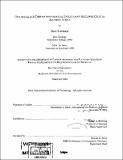| dc.contributor.advisor | Samuel A. Bowring. | en_US |
| dc.contributor.author | Schmitz, Mark D. (Mark David), 1972- | en_US |
| dc.contributor.other | Massachusetts Institute of Technology. Dept. of Earth, Atmospheric, and Planetary Sciences. | en_US |
| dc.date.accessioned | 2010-09-03T18:28:32Z | |
| dc.date.available | 2010-09-03T18:28:32Z | |
| dc.date.copyright | 2002 | en_US |
| dc.date.issued | 2002 | en_US |
| dc.identifier.uri | http://hdl.handle.net/1721.1/58368 | |
| dc.description | Thesis (Ph.D.)--Massachusetts Institute of Technology, Dept. of Earth, Atmospheric, and Planetary Sciences, 2002. | en_US |
| dc.description | Includes bibliographical references. | en_US |
| dc.description.abstract | Geochronological, thermochronological and isotopic studies of kimberlite-borne crustal xenoliths have been used to elucidate the architecture and thermal evolution of the continental lithosphere of southern Africa. U-Pb accessory mineral geochronology of lower crustal xenolith assemblages illustrate the youth of granulite-facies metamorphism relative to the ancient stabilization of the craton, and demonstrate two distinct processes for their generation. Granulitic lower crust at the craton margins and in the bounding Proterozoic belts was generated during 1.1 to 1.0 Ga Namaqua-Natal orogenesis, in response to collisional crustal thickening. Ultra-high temperature granulites in the central cratonic lower crust were generated during dramatic advective perturbation of the lithosphere during 2.7 Ga Ventersdorp rifting and magmatism. Utilizing the U-Pb systematics of titanite, apatite and rutile- minerals with closure temperatures for Pb diffusion of 650 to 400ʻC- the thermal evolution of the lower crust and underlying lithosphere has been constrained. Thermal relaxation times for the lithosphere following tectonothermal perturbation indicated by these data (400-600 Ma) are consistent with predictions of simple conductive cooling models, however initial cooling rates in the lithosphere are slower than predicted. Closure of the U-Pb system in rutile, heralding the establishment of cratonic geotherms in the Proterozoic belts of southern Africa by 700 Ma, demands lithospheric thickness comparable to that beneath the Archean cratons. | en_US |
| dc.description.abstract | (cont.) Lower crustal thermochronology also reveals the influence of a thermal perturbation to the southern African lithosphere in the Late Mesozoic, consistent with a broad upper mantle thermal anomaly associated with southern Gondwana breakup. The patterns of lower crustal heating are spatially and temporally complex, suggesting the importance of pre-existing lithospheric structure as a control on advective focussing. U-Pb zircon geochronology of basement lithologies from the western Kimberley domain of the Kaapvaal craton constrain a model for Neoarchean accretion of the Kimberley block to the eastern Kaapvaal shield at 2.9 Ga. The timing of this convergence through subduction beneath the western domain is correlated with a variety of Re-Os model ages for the underlying lithospheric mantle of the western craton, including peridotite depletion ages, eclogite formation ages and sulfide diamond inclusion ages, and suggests significant coupling of continental crust and lithospheric mantle formation and modification during convergent margin processes. | en_US |
| dc.description.statementofresponsibility | by Mark D. Schmitz. | en_US |
| dc.format.extent | 271 p. | en_US |
| dc.language.iso | eng | en_US |
| dc.publisher | Massachusetts Institute of Technology | en_US |
| dc.rights | M.I.T. theses are protected by
copyright. They may be viewed from this source for any purpose, but
reproduction or distribution in any format is prohibited without written
permission. See provided URL for inquiries about permission. | en_US |
| dc.rights.uri | http://dspace.mit.edu/handle/1721.1/7582 | en_US |
| dc.subject | Earth, Atmospheric, and Planetary Sciences. | en_US |
| dc.title | Geological and thermochronological evolution of the lower crust of southern Africa | en_US |
| dc.type | Thesis | en_US |
| dc.description.degree | Ph.D. | en_US |
| dc.contributor.department | Massachusetts Institute of Technology. Department of Earth, Atmospheric, and Planetary Sciences | |
| dc.identifier.oclc | 50631438 | en_US |
